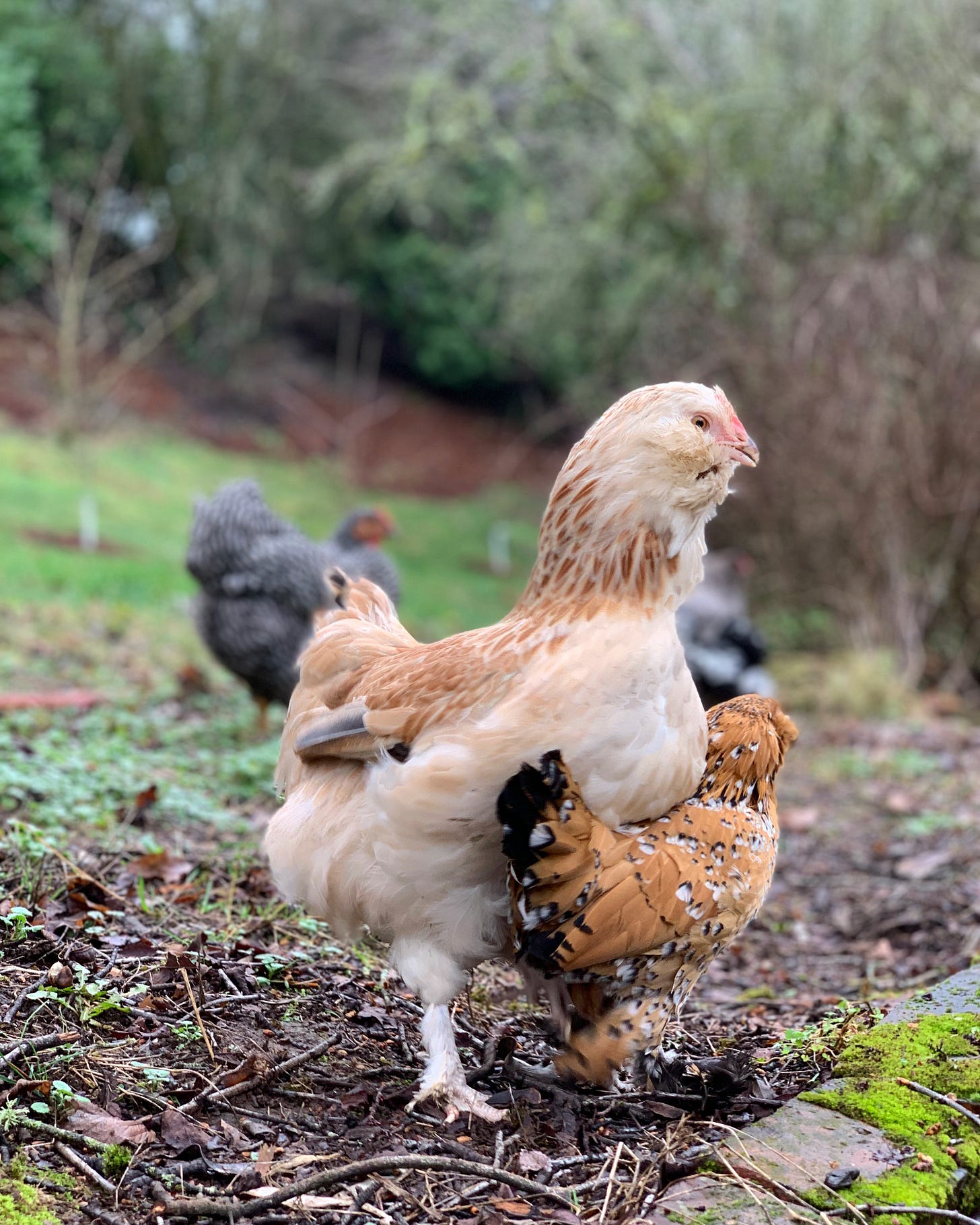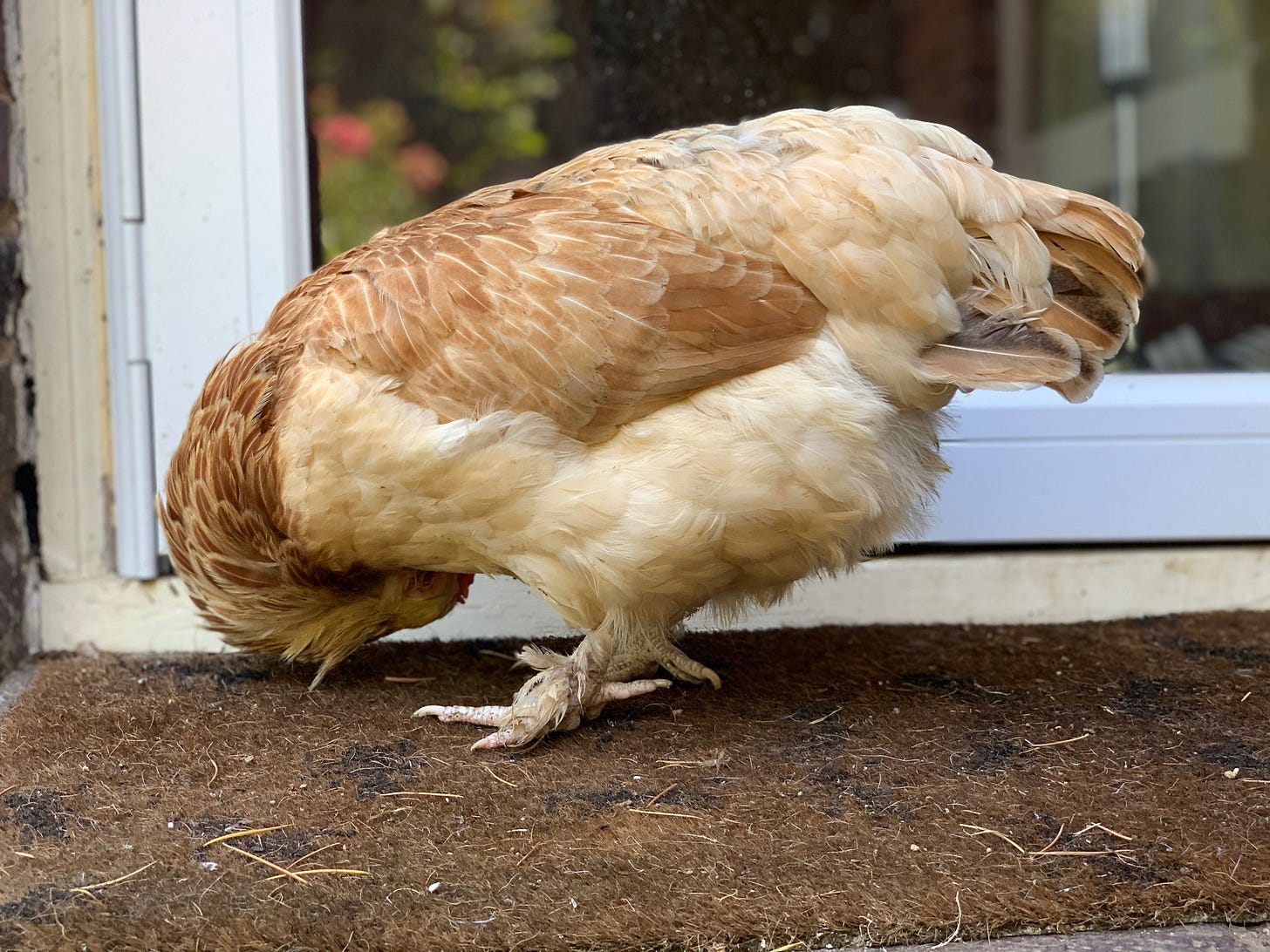There’s a phrase “living my best life” that people use a lot on social media. It’s often attached to innocuous activities—going to the beach, eating a $15 toast, spending the day picking apples—and #jokingnotjoking in the way that so many of us do online. But the idea of living a good life and what that means is something that’s been on my mind a lot lately. Probably yours as well. All of our lives have looked so different since March. We’ve all had to adjust our view of what a good day is, masks and all. But it’s also something I’ve thought of on and off since December when it became clear that something was very wrong with my Salmon Faverolle Dolly.

(Dolly “hiding” next to Emmylou)
Dolly, like most Faverolles, is an odd bird. They’re often referred to as “barnyard comedians” because the breed is prone to strange behavior. First of all, Dolly doesn’t make noises like the other chickens do—she honks. She’s always been toward the bottom of the pecking order and extremely sensitive. When she was young, she was best friends with my tiny Mille Fleur D’uccle Bantam, Emmylou. Once I saw one of the other chickens peck at Dolly who immediately ran to hide behind her small friend.
She’s always been a bit of a tattle-tale: quick to bully other chickens but sensitive if anyone pecks her in return. And maybe she is more fragile than the others. When I got her as a chick, she didn’t eat for three days despite all my efforts to coax her toward chick feed and more enticing treats. There’s something called “failure to thrive” that just means a chick can’t do what it takes to keep themselves alive. I thought maybe that was her story. Somehow she figured it out—better late than never. Everything was fine, barring a few small chicken-on-chicken injuries. Then one day, she started holding her neck at a strange angle and walking backwards, honking angrily. She could get into the nest box at bedtime or when she had to lay an egg but I soon realized she couldn’t easily get out of it again. I brought her inside for some TLC. After a few days, she was better. Crisis averted.
The symptoms came back in February. Worse this time. Now she couldn’t get into the nest box at all and I’d go into the coop at night to find her in a pile of feathers on the ground. I started putting her to bed and gently setting her back on the floor of the run in the morning. When I took her to a local vet, she was in such a bad state that I thought I might be saying goodbye in that fluorescent office. But the vet thought it was wry neck, often caused by a vitamin deficiency. Theoretically curable! I had hope. Dolly got better again. She got worse again too.
I’ve gotten very attached to Dolly during all this time. Between all of her visits inside, she’s probably spent over a month as a house chicken. Now when I sit in the yard, she sometimes walks up to me and settles herself against my leg to go to sleep. None of the other chickens like to cuddle. Now when one of the other chickens picks on her, she runs and hides behind my legs. I always found it a bit cheesy when rescuers talk about how an animal “knew I was there to help” but there you go.
I know so much about her quirks compared to the other hens and yet when I look at Dolly on one of her bad days, when she honks with frustration because she can’t aim her beak to get the mealworm treats from my hands or walks backwards in small fast circles or sleeps most of the day on her feet with her head bent toward the ground, I don’t know if she’s still living her best life or not.

(Dolly on a bad day)
In addition to our ten chickens, we also have two dogs. If either of them got sick, I feel fairly sure I know what brings them joy enough to know if their lives had gotten to a point where, as people gently say, “it’s time.” For Bandit, who never wants to be more than a few feet away from me, it would be when he couldn’t follow me around and had to be left alone—in another room or floor of the house. For Mesa, who loves nothing more than sitting underneath our 100-year-old deodar cedar and surveying her domain, it would be the day she couldn’t enjoy hours in the sun anymore.
It’s different with Dolly and the other chickens. I don’t know why. I know that they enjoy treats and dust baths. I know that they get upset when I take too long to let them out of the run to free-range in the yard. Humans have given chickens so little for so long—a small cage, no sunlight, bred them to be fatter or lay more eggs—and they’ve survived it. Sometimes I wonder if what my friends refer to as the “chicken paradise” I’ve created in the yard is actually just someone meeting their basic needs on a still-rare occasion. It doesn’t help that a chicken’s favorite “hobbies” like perching or foraging for food or taking dust baths could all be seen as basic survival skills that keep them away from predators, feed them, and help clean their feathers. I like to think they enjoy it too, that it’s something more than utilitarian. But if I can’t say what brings them absolute joy and happiness, I also can’t say when the joy is gone. When “it’s time.”
We took Dolly to another vet with more chicken experience a few months ago. She told us that Dolly had actually suffered some form of spinal trauma and that her neck, especially after all this time, may or may not heal. I gave Dolly more medicine (I can tell you that giving chickens a small pill is much easier than a liquid) and I reached through the fluff to give her chicken neck massages. She got better. She got worse. Last week she got a shot of cortisone which, the vet said, is the thing they try when they’ve tried everything else.
The last few days have been bad. Yesterday she was mostly despondent but then she hungrily gobbled a piece of my ripe summer peach, took a dust bath, then ate a bit of banana I gave her later. For those moments, she seemed as happy as she ever is. If she never gets all the way or even a little bit better, I have to decide whether those moments are enough. I want to know what Dolly’s best life is and then give it to her. I hope tomorrow is a good day.
News From the Coop!
Harriet laid her first egg this week! Even for bantam pullet eggs (pullet is the term for a hen under a year old) they are extraordinarily tiny. Twenty-six grams! A large egg is roughly twice that size. We now have so many chickens that a few of them lay the same color/size eggs which will make it hard to know who is laying what…and where. Yesterday, I spent twenty minutes looking for Emmylou who was off hiding her eggs in an as-of-yet-undiscovered nesting location. She finally emerged from hiding right after I turned the sprinkler on. She was wet and mad about the whole ordeal. I have to admit, after searching for so long, I did not have much sympathy.
If you liked this email, please share it with a chicken or animal lover in your life! As always, email me at underthehenfluence@gmail.com with any tips or comments. See you in two weeks.
-Tove




This is really just beautiful. Brought me to tears. Dolly is so lucky to have you. Thanks for sharing her story.
My favorelle is doing the same thing. What happened with your girl?